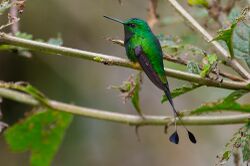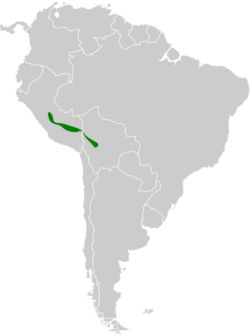Biology:Rufous-booted racket-tail
| Rufous-booted racket-tail | |
|---|---|

| |
| Male | |
| Scientific classification | |
| Domain: | Eukaryota |
| Kingdom: | Animalia |
| Phylum: | Chordata |
| Class: | Aves |
| Clade: | Strisores |
| Order: | Apodiformes |
| Family: | Trochilidae |
| Genus: | Ocreatus |
| Species: | O. addae
|
| Binomial name | |
| Ocreatus addae (Bourcier, 1846)
| |

| |
| Synonyms[3] | |
| |
The rufous-booted racket-tail (Ocreatus addae) is a species of hummingbird in the "brilliants", tribe Heliantheini in subfamily Lesbiinae. It is found in Bolivia and Peru.[4][5]
Taxonomy and systematics
The rufous-booted racket-tail, as defined by the International Ornithological Committee (IOC) and the Clements taxonomy, is one of three species in genus Ocreatus. However, BirdLife International's Handbook of the Birds of the World (HBW) treats the taxon as one of eight subspecies of booted racket-tail (O. underwoodii). The IOC and Clements call underwoodii "white-booted racket-tail" and assign five subspecies to it. HBW splits the Peruvian population from O. underwoodii addae as O. underwoodii annae, leaving the former as a Bolivian endemic subspecies.[4][5][6] The South American Classification Committee of the American Ornithological Society (SACC) follows the eight-subspecies model of booted racket-tail but has requested a proposal to elevate O. addae, O. annae, and another subspecies to species status.[7]
The specific epithet addae honors Mrs. Adda Wilson.[8]
Description
All racket-tails have pronounced sexual dimorphism. Only the male has elongated outer rectrices (tail feathers) that have bare shafts with terminal flags. On both the annae and addae racket-tails, those feathers are decurved and cross; the flags are asymmetric ellipses. Male rufous-booted racket-tails are 11 to 15 cm (4.3 to 5.9 in) long including the 5.5 to 6 cm (2.2 to 2.4 in) long outer tail feathers, and weigh 2.5 to 2.7 g (0.088 to 0.095 oz). Females are 7.6 to 9 cm (3.0 to 3.5 in) long and weigh 2.6 to 3.2 g (0.092 to 0.11 oz). Both sexes of annae and addae have greenish upperparts without a glittering forehead, both have a white spot behind the eye, and both have buff leg puffs. Males of annae have a greenish gray throat and a solid green belly. Their tail flags are dark bronzy purple. Females have a white throat and breast heavily spotted with green. Males of addae have a mostly white throat with some green and a white belly with green spots. Their tail flags are greenish black. Like annae, females have a white throat and breast heavily spotted with green.[9][10]
Distribution and habitat
The annae rufous-booted racket-tail is found on the east slope of the Andes of central and southern Peru. The addae rufous-booted racket-tail is found on the east slope of the Bolivian Andes. The species favors the edges of humid to wet forest but is also found in the forest interior and in more open secondary forest. It is most numerous at elevations between 1,600 and 2,200 m (5,200 and 7,200 ft) but is found as low as 600 m (2,000 ft) and as high as 4,000 m (13,000 ft).[10]
Behavior
Movement
The rufous-booted racket-tail makes seasonal elevational movements after breeding.[10]
Feeding
The rufous-booted racket-tail typically forages between 6 and 18 m (20 and 60 ft) above the ground. It takes nectar from a variety of plants such as those of genera Palicourea, Clusia, Inga, and Cavendishia. Often several birds will feed close together. In addition to feeding on nectar it captures small insects by hawking from a perch.[10]
Breeding
The rufous-booted racket-tail's breeding season has not been studied but might include most of the year. It makes a tiny cup nest of plant fiber and lichen, typically on a horizontal twig 6 to 8 m (20 to 30 ft) above the ground. The female incubates the clutch of two eggs for 16 to 17 days; fledging occurs 19 to 22 days after hatch.[10]
Vocalization
Both male and female rufous-booted racket-tails give "a diagnostic, descending, thin sweet trill, 'ti-tlee-ee-ee' [and] single 'tsit' and 'trrt' notes."[10]
Status
The IUCN follows HBW taxonomy and so recognizes only one species of Ocreatus as the booted racket-tail. It has assessed the species as being of Least Concern. It has a large range, and though its population size is not known it is believed to be stable. No immediate threats are known.[1] The racket-tail complex as a whole is very common and occurs in several protected areas.[10]
References
- ↑ 1.0 1.1 BirdLife International (2016). "Booted Racket-tail Ocreatus underwoodii". IUCN Red List of Threatened Species 2016: e.T22687968A93177284. doi:10.2305/IUCN.UK.2016-3.RLTS.T22687968A93177284.en. https://www.iucnredlist.org/species/22687968/93177284. Retrieved 4 May 2022.
- ↑ "Appendices | CITES". https://cites.org/eng/app/appendices.php.
- ↑ "Ocreatus addae". Species. GBIF. http://www.gbif.org/species/7948873.
- ↑ 4.0 4.1 "Hummingbirds". January 2022. https://www.worldbirdnames.org/new/bow/hummingbirds/.
- ↑ 5.0 5.1 HBW and BirdLife International (2020) Handbook of the Birds of the World and BirdLife International digital checklist of the birds of the world Version 5. Available at: http://datazone.birdlife.org/userfiles/file/Species/Taxonomy/HBW-BirdLife_Checklist_v5_Dec20.zip [.xls zipped 1 MB] retrieved 27 May 2021
- ↑ Clements, J. F., T. S. Schulenberg, M. J. Iliff, T. A. Fredericks, J. A. Gerbracht, D. Lepage, S. M. Billerman, B. L. Sullivan, and C. L. Wood. 2022. The eBird/Clements checklist of birds of the world: v2022. Downloaded from https://www.birds.cornell.edu/clementschecklist/download/ retrieved November 10, 2022
- ↑ Remsen, J. V., Jr., J. I. Areta, E. Bonaccorso, S. Claramunt, A. Jaramillo, D. F. Lane, J. F. Pacheco, M. B. Robbins, F. G. Stiles, and K. J. Zimmer. Version 24 July 2022. A classification of the bird species of South America. American Ornithological Society. https://www.museum.lsu.edu/~Remsen/SACCBaseline.htm retrieved July 24, 2022
- ↑ Beolens, Bo; Watkins, Michael; Grayson, Michael (2014) (in en). The Eponym Dictionary of Birds. Bloomsbury Publishing. ISBN 9781472905741. https://books.google.com/books?id=En4wBAAAQBAJ&q=Mrs+Adda+Wilson.
- ↑ Schuchmann, Karl-L.; Weller, André-A.; Jürgens, Dietmar (2016). "Biogeography and taxonomy of racket-tail hummingbirds (Aves: Trochilidae: Ocreatus): Evidence for species delimitation from morphology and display behavior". Zootaxa 4200 (1): 83. doi:10.11646/zootaxa.4200.1.3. PMID 27988640. https://www.researchgate.net/publication/311004563.
- ↑ 10.0 10.1 10.2 10.3 10.4 10.5 10.6 Schuchmann, K.L. and P. F. D. Boesman (2020). Booted Racket-tail (Ocreatus underwoodii), version 1.0. In Birds of the World (J. del Hoyo, A. Elliott, J. Sargatal, D. A. Christie, and E. de Juana, Editors). Cornell Lab of Ornithology, Ithaca, NY, USA. https://doi.org/10.2173/bow.bortai1.01 retrieved 4 May 2022
Wikidata ☰ Q30693869 entry
 |


